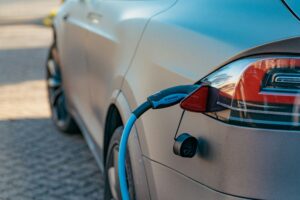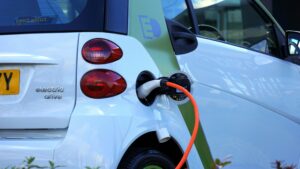Electric Vehicle details:

Electric vehicles (EVs) are vehicles that use electric motors for propulsion, as opposed to internal combustion engines (ICEs) that burn fossil fuels. They come in various types, and their popularity has been growing due to advancements in technology, concerns over climate change, and the desire to reduce dependency on fossil fuels. Below is a detailed overview of EVs, covering their types, components, benefits, and challenges.
Types of Electric Vehicles:

- Battery Electric Vehicles (BEVs):
- Description: BEVs are fully electric vehicles that rely solely on batteries to store energy for their electric motors.
- Examples: Tesla Model 3, Nissan Leaf, Chevrolet Bolt.
- Charging: They require external charging from an electric grid using standard or fast-charging stations.
- Plug-in Hybrid Electric Vehicles (PHEVs):
- Description: PHEVs have both an electric motor and an internal combustion engine. They can be charged from the grid and operate on electricity for short trips, but the gasoline engine kicks in for longer trips.
- Examples: Toyota Prius Prime, Ford Escape Plug-In Hybrid.
- Charging: They can be plugged into an external power source but also have a gasoline engine that charges the battery or powers the car.
- Hybrid Electric Vehicles (HEVs):
- Description: HEVs combine a gasoline engine with an electric motor, but they cannot be plugged in to charge. The battery is charged through regenerative braking and by the gasoline engine.
- Examples: Toyota Prius, Honda Insight.
- Charging: No external charging needed; they charge the battery via regenerative braking and the combustion engine.
- Fuel Cell Electric Vehicles (FCEVs):
- Description: FCEVs use hydrogen gas to power an electric motor. They produce electricity in a fuel cell by combining hydrogen with oxygen.
- Examples: Toyota Mirai, Hyundai Nexo.
- Fueling: Hydrogen refueling stations are needed, which are currently limited in many parts of the world.
Key Components of Electric Vehicles:

- Battery Pack:
- The heart of the EV, where electrical energy is stored.
- Typically lithium-ion batteries due to their high energy density and efficiency.
- Battery capacity is measured in kilowatt-hours (kWh); the higher the kWh, the more range the vehicle has.
- Electric Motor:
- Converts electrical energy into mechanical energy to drive the wheels.
- Can either be an AC induction motor or a permanent magnet motor.
- EVs often have more than one motor for all-wheel drive (AWD) capabilities.
- Inverter:
- Converts the DC (direct current) stored in the battery into AC (alternating current) used by the electric motor.
- Onboard Charger:
- Converts AC from the grid into DC to charge the battery when plugged in.
- Regenerative Braking System:
- Captures energy normally lost as heat during braking and converts it into electricity, which is fed back into the battery.
- Charging Ports:
- Used to connect the vehicle to a charging station. There are different types of chargers, from slow home chargers (Level 1) to fast public charging stations (Level 2 and DC Fast Charging).
Benefits of Electric Vehicles:

- Environmental Benefits:
- Zero tailpipe emissions in BEVs and FCEVs, significantly reducing air pollution.
- Lower greenhouse gas emissions, especially when charged using renewable energy.
- Reduced reliance on fossil fuels.
- Energy Efficiency:
- Electric motors are much more efficient than combustion engines, converting up to 90% of energy into movement, whereas gasoline engines convert only 20-30%.
- Regenerative braking helps recapture energy.
- Lower Operating Costs:
- Electricity is generally cheaper than gasoline or diesel.
- Fewer moving parts reduce maintenance costs (no oil changes, fewer repairs).
- Performance:
- Electric motors provide instant torque, delivering quick acceleration.
- EVs often offer smooth and quiet driving experiences.
Challenges of Electric Vehicles:

- Range Anxiety:
- The limited range of some electric vehicles is a concern for long-distance travel, although this is improving with advancements in battery technology.
- Charging Infrastructure:
- Charging stations, especially fast-charging stations, are still not as ubiquitous as gas stations, which can cause concerns about charging availability.
- Charging Time:
- Even with fast chargers, it can take 30 minutes to an hour to charge a battery to 80%, which is longer than refueling a gasoline vehicle.
- Battery Life and Cost:
- EV batteries degrade over time, and replacement can be expensive, though most EV manufacturers offer long battery warranties (often 8 years or 100,000 miles).
- Battery production also requires raw materials like lithium, cobalt, and nickel, which have environmental and ethical concerns in their extraction.
- Upfront Cost:
- While prices are coming down, EVs still tend to be more expensive upfront compared to their gasoline counterparts, although government incentives and the lower operating costs often offset this over time.
Future of Electric Vehicles:

- Battery Technology: Solid-state batteries, which promise higher energy density, faster charging, and increased safety, are being developed and could revolutionize the EV market.
- Autonomous Driving: Many EV manufacturers are integrating autonomous driving technologies, which could change how we interact with vehicles in the future.
- Sustainability: Efforts to recycle batteries and source materials more responsibly are crucial for the long-term sustainability of EVs.
- Renewable Energy Integration: EVs and renewable energy sources like solar power are being integrated to create cleaner transportation networks.
Electric vehicles are a key part of the global shift towards sustainable transportation. As technology improves, many of the current limitations are expected to be resolved, making EVs an increasingly viable option for the mass market.
